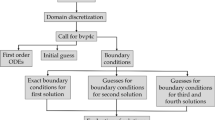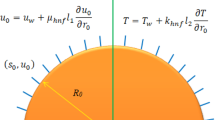Abstract
Ferrofluids (FF) have numerous applications in biomedical, industrial and mechanical engineering. It characteristics make it helpful for a wide range of uses like in computer hard drives, loudspeakers, rotating shaft motors, magnetic resonance imaging (MRI) and so many others. In this communication, characteristics of magnetized first order Darcy–Forchheimer ferrofluid slip flow of non-Newtonian (Williamson fluid) towards a flat surface of stretched sheet in the presence of chemical reaction, Brownian motion, activation energy, thermophoresis diffusion, mixed convection and Robin condition is addressed. Appropriate similarity transportations are used to alter the complicated and nonlinear PDE’s into ODE’s and computational results are obtained through bvp4c technique (built-in-shooting). Furthermore, the engineering quantities (skin friction coefficient, Nusselt number, Sherwood number) are numerically elaborated with the help important flow parameters. In summary, a proper location of magnetic dipole can adjust the heat and mass transfer rate and flow field to fit the practical application.










Similar content being viewed by others
References
Abbas Z, Hasnain J, Aly S, Sheikh M (2020a) Comparative analysis for partial slip flow of ferrofluid Fe3O4 nanoparticles in a semi-porous channel. J King Saud Uni Sci 32:2646–2655
Abbas SZ, Khan MI, Kadry S, Khan WA, Israr-Ur-Rehman M, Waqas M (2020b) Fully developed entropy optimized second order velocity slip MHD nanofluid flow with activation energy. Comput Methods Progr Biomed 190:105362
Abbas SZ, Khan WA, Kadry S, Khan MI, Waqas M, Khan MI (2020c) Entropy optimized Darcy–Forchheimer nanofluid (silicon dioxide, molybdenum disulfide) subject to temperature dependent viscosity. Comput Methods Progr Biomed 190:105363
Acharya N, Das K, Kundu PK (2018) Rotating flow of carbon nanotube over a stretching surface in the presence of magnetic field: a comparative study. Appl Nanosci 8:369–378
Ahmad S, Khan MI, Hayat T, Khan MI, Alsaedi A (2018) Entropy generation optimization and unsteady squeezing flow of viscous fluid with five different shapes of nanoparticles. Coll Surf A Physicochem Eng Asp 554:197–210
Bahiraei M, Mazaheri N, Daneshyar MR (2020) CFD analysis of second law characteristics for flow of a hybrid biological nanofluid under rotary motion of a twisted tape: energy destruction and entropy generation analyses. Powder Technol 372:351–361
Bozhko A, Putin G (2009) Thermomagnetic convection as a tool for heat and mass transfer control in nanosize materials under microgravity conditions. Microgr Sci Technol 21:89–93
Choi SUS (1995) Enhancing thermal conductivity of fluids with nanoparticles. In: Proceedings of the 1995 ASME International Mechanical Engineering Congress and Exposition, FED 231/MD 66, pp. 99–105
Ghorbani B, Ebrahimi S, Vijayaraghavan K (2018) CFD modeling and sensitivity analysis of heat transfer enhancement of a ferrofluid flow in the presence of a magnetic field. Int J Heat Mass Transf 127:544–552
Goharkhah M, Ashjaee M (2014) Effect of an alternating nonuniform magnetic field on ferrofluid flow and heat transfer in a channel. J Magn Magn Mater 362:80–89
Hayat T, Khan MI, Farooq M, Gull N, Alsaedi A (2016) Unsteady three-dimensional mixed convection flow with variable viscosity and thermal conductivity. J Mol Liq 223:1297–1310
Hayat T, Ahmad S, Khan MI, Alsaedi A (2018) Simulation of ferromagnetic nanomaterial flow of Maxwell fluid. Results Phys 8:34–40
Jamshed W, Aziz A (2018) Cattaneo–Christov based study of TiO2-CuO/EG Casson hybrid nanofluid flow over a stretching surface with entropy generation. Appl Nanosci 8:685–698
Khan MI, Alzahrani F (2020) Activation energy and binary chemical reaction effect in nonlinear thermal radiative stagnation point flow of Walter-B nanofluid: numerical computations. Int J Modern Phys B 34:2050132
Khan MI, Hayat T, Khan MI, Waqas M, Alsaedi A (2019) Numerical simulation of hydromagnetic mixed convective radiative slip flow with variable fluid properties: a mathematical model for entropy generation. J Phys Chem Solid 125:153–164
Khan MI, Alzahrani F, Hobiny A (2020a) Simulation and modeling of second order velocity slip flow of micropolar ferrofluid with Darcy–Forchheimer porous medium. J Mater Resear Techno 9:7335–7340
Khan I, Lan J, Gao M, Huang S, Wu C (2020b) Electron beam-induced changes in tips of multi-walled carbon nanotubes with/without Au nanoparticles. Appl Nanosci 10:1521–1534
Khan MI, Alzahrani F, Hobiny A (2020c) Heat transport and nonlinear mixed convective nanomaterial slip flow of Walter-B fluid containing gyrotactic microorganisms. Alex Eng J 59:1761–1769
Khan MI, Qayyum S, Kadry S, Khan WA, Abbas SZ (2020d) Irreversibility analysis and heat transport in squeezing nanoliquid flow of non-Newtonian (second-grade) fluid between infinite plates with activation energy. Arab J Sci Eng 45:4939–4947
Khan MI, Qayyum S, Kadry S, Khan WA, Abbas SZ (2020e) Theoretical investigations of entropy optimization in electro-magneto nonlinear mixed convective second order slip flow. J Magn 25:8–14
Lajvardi M, Moghimi-Rad J, Hadi I, Gavili A, Dallali Isfahani T, Zabihi F, Sabbaghzadeh J (2010) Experimental investigation for enhanced ferrofluid heat transfer under magnetic field effect. J Magn Magn Mater 322:3508–3513
Minkowycz WJ, Sparrow E, Abraham JP (2013) Nanoparticle heat transfer and fluid flow, 1st edn. CRC Press, Boca Raton, p 9780429063398
Muhammad R, Khan MI, Khan NB, Jameel M (2020a) Magnetohydrodynamics (MHD) radiated nanomaterial viscous material flow by a curved surface with second order slip and entropy generation. Comput Methods Prog Biomed 189:105294
Muhammad R, Khan MI, Jameel M, Khan NB (2020b) Fully developed Darcy–Forchheimer mixed convective flow over a curved surface with activation energy and entropy generation. Comput Methods Prog Biomed 188:105298
Nayak MK, Shaw S, Khan MI, Pandey VS, Nazeer M (2020) Flow and thermal analysis on Darcy–Forchheimer flow of copper-water nanofluid due to a rotating disk: a static and dynamic approach. J Mater Res Technol 9:7387–7408
Nkurikiyimfura I, Wang Y, Pan Z (2013) Heat transfer enhancement by magnetic nanofluids—a review. Renew Sustain Energy Rev 21:548–561
Odenbach S (1995) Microgravity experiments on thermomagnetic convection in magnetic fluids. J Magn Magn Mater 149:155–157
Odenbach S (2003) Ferrofluids-magnetically controlled suspensions. Coll Surf A Physicochem Eng Asp 217:171–178
Prakash J, Tripathi D, Bég OA (2020) Comparative study of hybrid nanofluids in microchannel slip flow induced by electroosmosis and peristalsis. Appl Nanosci 10:1693–1706
Qayyum S, Khan MI, Hayat T, Alsaedi A (2018) Comparative investigation of five nanoparticles in flow of viscous fluid with Joule heating and slip due to rotating disk. Phys B Cond Matt 534:173–183
Rashid M, Khan MI, Hayat T, Khan MI, Alsaedi A (2019) Entropy generation in flow of ferromagnetic liquid with nonlinear radiation and slip condition. J Mol Liq 276:441–452
Tang G, Han Y, Lau BL, Zhang X, Rhee DM (2015) An efficient single phase liquid cooling system for microelectronic devices with high power chip. 1:15803942
Xuan Y, Li Q, Ye M (2007) Investigations of convective heat transfer in ferrofluid microflows using lattice-Boltzmann approach. Int J Therm Sci 46:105–111
Zahmatkesh R, Mohammadiun H, Mohammadiun M, Bonab MHD (2019) Investigation of entropy generation in nanofluid’s axisymmetric stagnation flow over a cylinder with constant wall temperature and uniform surface suction-blowing. Alex Eng J 58:1483–1498
Acknowledgements
The research was supported by the National Natural Science Foundation of China (Grant Nos. 11971142, 11871202, 61673169, 11701176, 11626101, 11601485).
Author information
Authors and Affiliations
Corresponding authors
Additional information
Publisher's Note
Springer Nature remains neutral with regard to jurisdictional claims in published maps and institutional affiliations.
Rights and permissions
About this article
Cite this article
Khan, M.I., Khan, W.A., Waqas, M. et al. Role of dipole interactions in Darcy–Forchheimer first-order velocity slip nanofluid flow of Williamson model with Robin conditions. Appl Nanosci 10, 5343–5350 (2020). https://doi.org/10.1007/s13204-020-01513-9
Received:
Accepted:
Published:
Issue Date:
DOI: https://doi.org/10.1007/s13204-020-01513-9




